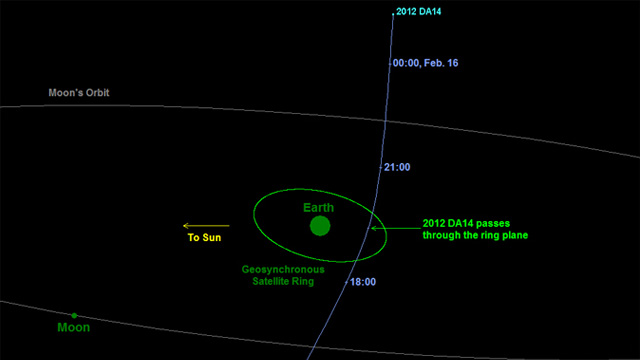While this is a far cry from the larger asteroids we know of, mostly in the Main Asteroid Belt, that average a mile across and can be as big as a few hundred miles, it is significantly larger than some of the Earth-grazers we've seen whiz by in the last few years, which have typically been only a few meters wide.
Asteroid 2012 DA14 is in the same size class as the rock responsible for blasting that mile-wide hole in the Arizona desert, known as Meteor Crater (a misnomer, as anyone who knows the difference between a meteor and a meteorite knows that meteors are pebbles that burn up in the atmosphere). If 2012 DA14 were to hit Earth, it would deliver a respectable wallop and leave a big hole or splash, but would not kill us all….
How close is it passing? That's the more interesting part of the story. With a closest approach to Earth's center of 21,200 miles (about 17,200 miles from Earth's surface), this is the closest approach by an asteroid of this size since we really started giving these objects much attention. This is slightly within the distance of geosynchronous satellites that circle the Earth—effectively making this passage a successful rim-shot (and thankfully not a slam-dunk).
So 2012 DA14 won't hit Earth, but will it hit any of the geostationary satellites that transmit Dish and TV satellite programming? We place those satellites in a ring at the geosynchronous distance—about 22,236 miles—so that their period of revolution around the Earth matches the Earth's rotation and they always remain at the same point in our sky, enabling constant line-of-sight transmission. So, will the asteroid cause a signal blackout while you're watching a football game?
Thankfully, physics to the rescue again. This will be a rim-shot where the ball comes close to hitting the rim, but will swish right through without contact.
So, since this is the largest-closest rock to pass through these parts since we started looking for them, will we be able to see this asteroid?
2012 DA14 won't be visible to the unaided eye even at closest approach, but should be visible at least through a small telescope. Also, we are planning to offer the public a look through one or more of our telescopes at Chabot Space & Science Center that Friday evening (weather permitting). If conditions are right, we should be observing the passage from early evening (telescopes open at 7:30 PM) onward until closing at 10:30. So come on up for a Near-miss Celebration!
